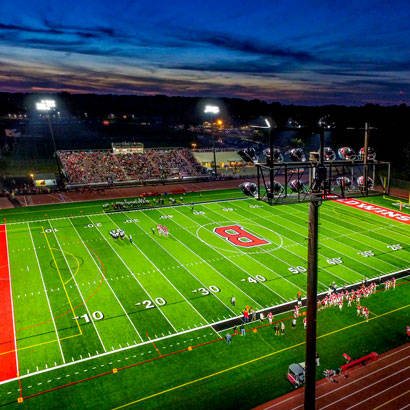
LED sports lighting is all the rage as more than one-third of all pro teams in the big four sports (MLB, NFL, NBA and NHL) have replaced the antiquated metal halide lighting systems at their stadiums and arenas with a controllable and energy-efficient LED lighting solution. Players benefit from the enhanced lighting, fans enjoy the entertaining light shows and the facility operations staff revel in the unmatched controllability and near-elimination of all maintenance.
Once the technology was proven, it became easier for professional sports venue operators to make the switch to LED lighting. But, for facility operators at local parks and municipal fields, the decision to make the switch is not as simple. There are more questions than answers, and for most facilities, it just doesn’t seem practical to install the same lighting fixtures that lit the Super Bowl for their Pop Warner football games.
LED lighting manufacturers understood these concerns and after several years of research, developed new products specifically to meet the needs of the municipal field market. Features, like color-temperature tuning to be optimized around multiple sports or picture clarity on HD TV broadcasts, that were important to professional teams were unnecessary for municipal fields. Following are the five most common questions LED manufacturers hear from municipalities trying to understand how LED lighting can work for them:
Is it true that the energy savings will essentially pay for the system?
Although it is true that an LED lighting solution costs more than a legacy system, with the combination of energy savings and especially the elimination of maintenance costs — depending upon usage and local energy costs — most municipalities should see a return-on-investment in under 10 years. You should also be aware that many power companies, state agencies and municipalities offer clean energy incentives when switching to LED that can further reduce costs.
I’m hesitant to remove my current lights and poles. Is that required?
We agree that this is an unnecessary step and one that we understand. We offer LED retrofit solutions that can be mounted on your existing infrastructure. You’ll save tremendously on the installation costs and you won’t need to shut your field down for weeks while the old poles are removed and the new poles are installed. Additionally, there are systems that are controlled wirelessly, so whether it’s a retrofit or new installation, you’ll also save on control wiring.
Light pollution is a big concern as my fields are in a residential neighborhood — what about that?
If you already have lights on your field, your neighbors will be thrilled if you switch to an LED system, as the leading LED lighting solutions deliver uniform light on the field much more efficiently than metal halide and significantly reduce unwanted light spill and sky glow. For every 5 foot candles of light spillage from a typical metal halide system, you can expect one-half foot candles from most LED fixtures. If you don’t yet have lights because of petitions from the neighbors, the reduced light spill and the ability to program the lights on customized schedules — which could serve as security lights — might help get the installation approved.
Is it true that I can control the lights from my mobile phone?
There are a variety of control systems available and many of them do allow the flexibility to schedule the lights from your phone or through the web. The most important thing to understand is the total control that an LED system offers, such as zoning, scheduling and dimming. You can adjust the dimming of the lights from 1 to 100 percent depending upon your needs. We even know of one baseball facility that on rainy days, keeps the artificial turf infield lit and the grass outfield dark so that teams can take infield practice without damaging the outfield grass. Similarly, multi-field complexes can light only the fields necessary at any particular time, rather than a whole complex.
My biggest problem with my current lighting system is the maintenance cost. Are LED lighting solutions really maintenance free?
LEDs can’t claim to be 100 percent maintenance free, but for most facilities that make the switch, the maintenance costs become insignificant. There are no bulbs to replace and most systems are guaranteed to last for 300,000 hours. The newer control systems will warn you if a light is consuming an abnormal amount of power or running at too high of a temperature, which can be a sign of a problem or potential failure. Operators can then respond proactively, rather than suffer a failure during an event or usage.
These are some of the typical questions municipal field operators ask about the pros and cons of installing and LED lighting solution. But, since every facility and municipality is different there are plenty more. If you’re frustrated with the limitations of your current sports lighting system or are just curious to learn more, get a lighting audit of your facility to see exactly how an LED lighting solution can enhance your facility for the benefit of your community.
Mike Lorenz is President of Eaton’s Ephesus Lighting Business.

